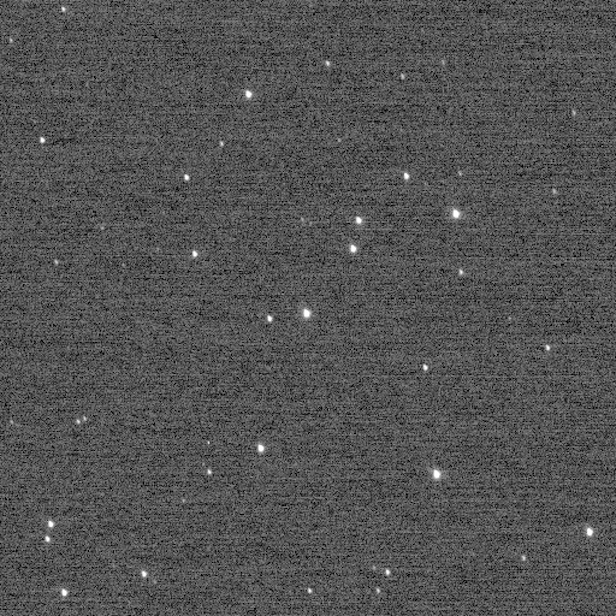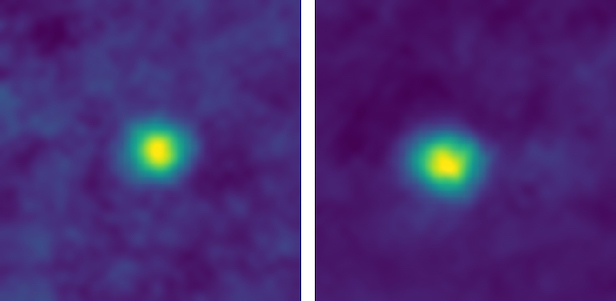New Horizons snaps record-breaking image in the Kuiper Belt…twice
New Horizons overtook Voyager 1’s record of most distant image ever taken from Earth

This calibration image of the Wishing Well cluster broke Voyager 1’s 27-year-old record for the most distant image ever taken by a spacecraft. Image credit: NASA/JHU/APL/SWRI
Records are made to be broken, and that’s exactly what NASA’s New Horizons spacecraft has done. On 5 December 2017, New Horizons snapped the farthest image ever made from Earth, until two hours later when it broke the record again. The previous record was held by NASA’s Voyager 1 image, which took the famous ‘Pale Blue Dot’ image of Earth from 6.06 billion kilometres away (3.75 billion miles).
On the 14 February 1990, Voyager 1 was on its journey towards the interstellar medium when it turned its camera around to get one last family portrait of our Solar System. This image was taken whilst being 40 and half times Astronomical Unites (AU) away from Earth, with one AU being the distance between the Sun and Earth. Shortly after this monumental portrait was taken, the cameras were switched off, and the record had remained unchallenged, until now.
New Horizons is just one of five spacecrafts to venture beyond our planets, so its current activities continue to set distance records. On 5 December, New Horizons underwent a routine calibration frame, which consisted of taking a picture of the Wishing Well open star cluster using the Long Range Reconnaissance Imager, abbreviated to LORRI. Just two hours later, LORRI broke its own record as it imaged the two Kuiper Belt Objects (KBOs) 2012 HZ84 and 2012 HE85. As the spacecraft retained its speed, travelling more than 1.1 million kilometres (700,000 miles) each day, it managed to broke the previous record by 60 million kilometres (40 million kilometres).

Only two hours after the Wishing Well image was taken, LORRI captured two images of the Kuiper Belt Objects 2012 HZ84 (left) and 2012 HE85 (right). Making it the new, farthest image ever taken. Image credit: NASA/JHU/APL/SWRI
“New Horizons has long been a mission of firsts — first to explore Pluto, first to explore the Kuiper Belt, fastest spacecraft ever launched,” says New Horizons Principal Investigator Alan Stern, of the Southwest Research Institute in Boulder, Colorado, United States. “And now, we’ve been able to make images farther from Earth than any spacecraft in history.”
Four days after the record-breaking snapshot was taken, New Horizons carried out the most-distant course-correction manoeuvre ever. The trajectory was changed to head towards the KBO named 2014 MU69, where it will make a close encounter on New Years Day of 2019. Shortly after the course change, New Horizons was sent into hibernation until 14 June 2018, when mission controllers at the John Hopkins Applied Physics Laboratory in Laurel, Maryland, United States, will awaken it from its slumber. The spacecraft will then be run through a series of tests, checks and activities in order to be suitably prepared for its approach to MU69.
In 2017, the New Horizons mission was extended with the aim to study at least two dozen other KBOs, dwarf planets and former KBOs that now have unstable orbits which intersect with the orbits of giant planets, also known as Centaurs. Mission scientists will study the images in an attempt to uncover the various shapes, sizes and other surface properties for such objects. The spacecraft is also making almost constant measurements of the plasma, dust and neutral-gas environment as it maintains its course further away from us.
Keep up to date with the latest reviews in All About Space – available every month for just £4.99. Alternatively you can subscribe here for a fraction of the price!




